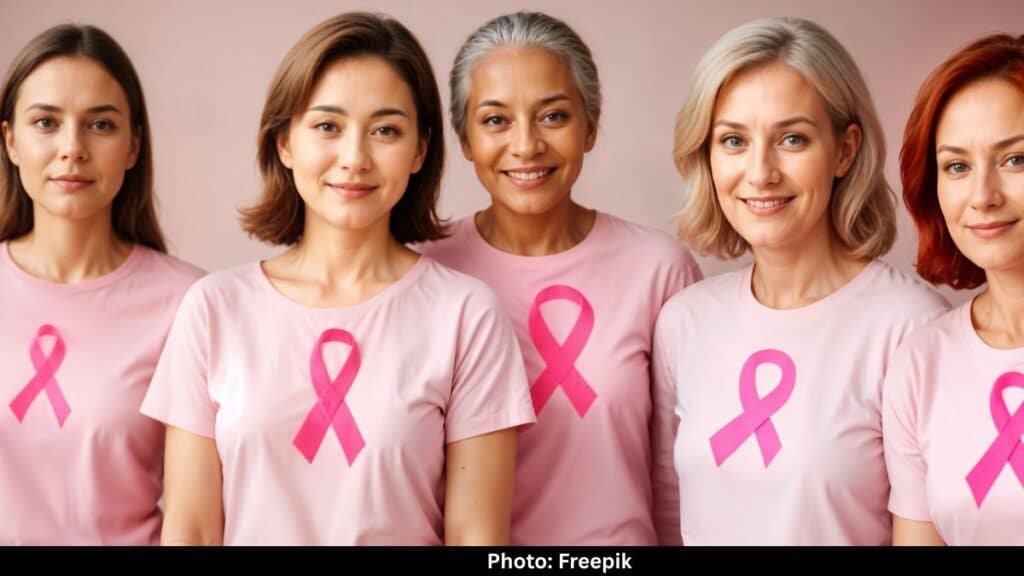Breast cancer doesn’t always happen by chance. For some people, it runs in families because of inherited genetic mutations. This is what’s known as hereditary breast cancer.
The most well-known culprits are mutations in the BRCA1 and BRCA2 genes, but they’re not the only ones. If you’ve ever wondered whether family history plays a role in breast cancer risk, what genetic mutations mean for you, and how screening works when you’re high risk, let’s break it all down.
Breast Cancer: A Common Cancer With Many Causes
Breast cancer is the most common cancer in people assigned female at birth, aside from certain types of skin cancer. According to the American Cancer Society, the average lifetime risk is about 13%. That means roughly one in eight women will develop breast cancer at some point in their life.
But not everyone faces the same level of risk. Family history and genetics can raise that number considerably. That’s why understanding the difference between ordinary genetic changes and inherited ones is so important.
Cancer and DNA Mutations: How It Starts
At its core, cancer is a disease of the genes. When DNA changes, or mutations, happen in certain genes, cells stop following normal rules. Instead of growing, dividing, and dying in an orderly way, they grow uncontrollably. That’s how tumors form.
Most of these genetic changes happen during a person’s lifetime. They’re called somatic mutations, and they can be triggered by natural aging, environmental factors like radiation, or lifestyle choices such as smoking. These are not inherited. You don’t pass them on to your children.
But in some cases, DNA mutations are inherited. That’s when things move into the realm of hereditary cancers.
What Exactly Is Hereditary Breast Cancer?
Hereditary breast cancer makes up about 5 to 10 percent of all breast cancer cases. In these situations, the higher risk of cancer comes from mutations in genes that are passed down from one or both parents.
The best known are the BRCA1 and BRCA2 genes. People who carry mutations in these genes face a much higher lifetime risk of breast cancer—about 70 percent by age 80. That’s more than five times the average risk.
These mutations also increase the chance of:
- Developing breast cancer at a younger age
- Being diagnosed with cancer in both breasts
- Higher risk for other cancers, like ovarian and pancreatic cancer
Here’s the key point: these mutations don’t only come from mothers. You can inherit them from your father just as easily. If one parent carries a BRCA mutation, each child has a 50 percent chance of inheriting it.
When Family History Doesn’t Fit the BRCA Story
It’s also possible to see breast cancer run in a family without any known gene mutation like BRCA showing up in testing. This can be frustrating because the pattern suggests heredity, but the genetics don’t yet explain it.
Scientists are still working on uncovering more inherited risk factors. Our understanding of breast cancer genetics is growing, and in time, more genes will likely be identified as contributors.
Beyond BRCA: Other Genes That Matter
While BRCA1 and BRCA2 mutations get the most attention, they’re not the only ones linked to hereditary breast cancer. Other inherited mutations, though less common, can raise risk too. Some of these involve rare genetic syndromes.
Here are a few key ones:
- PTEN: Mutations here cause Cowden syndrome, which increases the risk of several cancers, including breast cancer.
- TP53: This gene is tied to Li-Fraumeni syndrome, a condition associated with a very high lifetime cancer risk, including breast cancer.
- CDH1: Mutations here can lead to hereditary diffuse gastric cancer and raise the chance of lobular breast cancer.
- STK11: This gene is linked with Peutz-Jeghers syndrome, which comes with an increased risk of breast and other cancers.
In addition, mutations in other genes like PALB2, ATM, and CHEK2 are also linked to higher breast cancer risk. They may not carry as high a risk as BRCA, but they still matter when evaluating someone’s family history and personal risk profile.
How Inherited Mutations Work
To really grasp why inherited mutations are powerful, think about it this way: genes are like instruction manuals for how cells behave. If you inherit a flawed version of a gene that’s supposed to prevent cancer, your body starts the race with a disadvantage.
For instance, BRCA1 and BRCA2 are normally tumor suppressor genes. They help repair damaged DNA. But when they’re mutated, those repair systems don’t work properly, making it easier for cancer to develop.
Who Should Consider Genetic Testing?
Not everyone needs genetic testing for breast cancer risk. Doctors usually recommend it when there are strong clues in family history, such as:
- Multiple family members with breast cancer, especially at younger ages
- Cases of ovarian, pancreatic, or male breast cancer in the family
- A known BRCA mutation in a close relative
- Ashkenazi Jewish heritage, where BRCA mutations are more common
Genetic counselors play a key role here. They help individuals decide whether testing makes sense, interpret results, and discuss what steps to take next.
What Testing Can Reveal
Genetic testing can provide a lot of information, but it doesn’t deliver absolute answers. Testing may show:
- A positive result: You carry a mutation that increases risk.
- A negative result: No mutations were found in the genes tested.
- A variant of uncertain significance (VUS): A change in DNA was found, but its impact on cancer risk isn’t yet clear.
A positive result doesn’t mean you will definitely develop breast cancer. It means your risk is higher, and you can take preventive steps. A negative result doesn’t mean zero risk either—just that no known high-risk mutations were identified.
Screening Recommendations for High-Risk Individuals
For people with BRCA mutations or other high-risk genetic factors, screening starts earlier and is more intensive than for the average population. Typical recommendations include:
- Breast MRI beginning as early as age 25
- Mammograms often starting by age 30
- Screening every year, sometimes alternating MRI and mammogram every six months
In some cases, doctors may also recommend preventive surgeries, like prophylactic mastectomy (removal of breast tissue) or oophorectomy (removal of ovaries), to reduce risk. Medications like tamoxifen may also be considered for risk reduction.
What This Means for Families
Hereditary breast cancer isn’t just about one person. It affects families across generations. When one individual learns they carry a mutation, it often prompts testing and conversations with siblings, parents, and children.
This can be emotionally complex. Some people want to know their risk, while others prefer not to. Having open, supportive discussions and access to genetic counseling makes the process easier.
Lifestyle Still Plays a Role
Even with genetic risk, lifestyle choices matter. Maintaining a healthy weight, exercising regularly, limiting alcohol, and avoiding smoking can all help reduce overall cancer risk. Genetics set the stage, but environment and lifestyle still influence the story.
The Bottom Line
Hereditary breast cancer accounts for a smaller portion of cases overall, but for those affected, the impact is significant. Mutations in genes like BRCA1, BRCA2, and others can raise lifetime risk dramatically.
The good news is that awareness, testing, and proactive screening give people options. Knowing your genetic risk doesn’t mean living in fear—it means making informed choices about screening, prevention, and health.
If breast cancer runs in your family, it may be worth talking with a doctor or genetic counselor. The knowledge you gain could not only guide your own care but also support the health of future generations.
Disclaimer
This article is for informational purposes only and is not a substitute for professional medical advice, diagnosis, or treatment. Everyone’s body and experiences are different. If you have concerns about your sexual health, mental health, or experience any discomfort, please consult a qualified healthcare professional.




